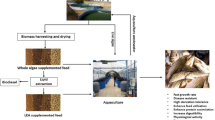Abstract
The goal in aquaculture systems is to maximize the efficiency of the flow of energy and nutrients toward the animal output. This is more complex than in terrestrial animal agriculture since the cultured organism is immersed in its aquatic environment and is often only one member of a food web system. The organic and inorganic inputs into the system are critical not only to the extent that they feed the cultured species directly, but they may also positively or negatively affect the environment supporting the animal, as well as fertilize other aspects of autotrophic and heterotrophic food webs within the system. Aquaculture systems are characterized by the density of animal biomass in a given area of water, which determines the intensity of management inputs required. Extensive systems rely on natural productivity for food; intensive systems require a high degree of management inputs including a complete diet for the species; systems between the two extremes are optimized by balancing applied feed with natural productivity. Balanced nutrient delivery remains an indispensable requirement, regardless of source, for growth of adults as well as larvae, for reproductive success and for generation of a high quality product.
Similar content being viewed by others
References
Bardach, J. E.; Ryther, J. H.; McLarney, W. O.: Aquaculture. The farming and husbandry of freshwater and marine organisms. Wiley Interscience, New York 1972.
Clithero, J. K.: Preflavoring live channel catfish. M. S. thesis, Kansas State University 1975.
Deshimaru, O.: Studies on nutrition and diet for prawn, Penaeus japonicus. Memoirs of Kagoshima Prefecture Fisheries Experiment Station Number 12, 1–118 (1981)
Ensor, P.: Korea: Deep-sea waters are getting murkier. Far Eastern Economic Review, 38–40 (2 August 1984)
Epifanio,, C. E.: Phytoplankton and yeast as foods for juvenile bivalves: a review of research at the University of Delaware. In: Pruder, G. D.; Langdon, C.; Conklin, D. (eds.), Proceedings of Second International Conference on Aquaculture Nutrition, 292–304, Delaware 1981.
Goyert, J. C.; Avault, J. W., Jr.: Agricultureal by-products as supplemental feed for crayfish, Procambarus clarkii. Transactions American Fisheries Society, 106, 6, 629–633 (1977)
Hepher, B.: Supplementary diets and related problems in fish culture. Proc. World Symp. on Finfish Nutrition and Fishfeed Technology, Vol I. Hamburg, 1979.
Hepher, B.; Pruginin, Y.: Commercial fish farming. Chapter 10, Nutrition and feeding, p. 192–206. John Wiley and Sons, New York 1981.
Kanazawa, A.: Penaeid nutrition. In: Pruder, G. D.; Langdon, C.; Conklin, D. (eds.), Proceedings of the Second International Conference on Aquaculture Nutrition, 87–105, Delaware 1981.
Klein-Macphee, G.; Howell, W. H.; Bech, A. D.: Comparison of a reference strain and four geographical strains of Artemia as food for winter flounder (Pseudopleuronectes americanus) larvae. Aquaculture 29, 279–288 (1982)
Lawrence, A. Z.; Johns, M. A.; Griffin, W. H.: Shrimp mariculture; state of the art. Report from Shrimp Mariculture Project, Texas A & M University 1983.
Liao, I.; Chao, N.: Development of prawn culture and its related studies in Taiwan. Paper presented at First International Biennial Conference on Warm Water Aquaculture — Crustacea, Birgham Young University, Laie, Hawaii, February 1983.
Malecha, S. R.; Buck, D. H.; Baur, R. J.; Onizuka, D. R.: Polyculture of the freshwater prawn, Macrobrachium rosenbergii, Chinese and common carps in ponds enriched with swine manure. I. Initial trials. Aquaculture 25, 101–116 (1981)
Maligalig, L. L.; Caul, J. F.; Tiemeier, O. W.: Aroma and flavor of farm-raised channel catfish: Effects of pond condition, storage and diet. Food Products Development (1973)
Marek, M.: Revision of supplementary feeding tables for pond fish. Bamidgeh, 27, 3, 57–64 (1975)
Moore, L. B.; Stanley, R. W.: Corn silage as a feed supplement for grow out of Macrobrachium rosenbergii in ponds. J. World Mariculture Society 13, 86–94 (1982)
Moore, L. B.; Stanley, R. W.; Malecha, S. R.: The effect of standing crop size on the growth response of Macrobrachium rosenbergii to the quality of applied feed. Paper presented at the World Mariculture Society Annual Meetings, Vancouver, Canada, March 1984.
Nagel, L.: Aquaculture in the third world. In: Animal Research and Development, Volume 9. Institute for Scientific Cooperation, Germany 1979.
National Research Council: Nutrient requirements of coldwater fishes. Nutrient Requirements of Domestic Animals, 16, National Academy Press, Washington, DC 1981.
Odum, W. E.: Utilization of the direct grazing and plant detritus food chains by the striped mullet Mugil cephalus. In: Steele, J. H. (ed.), Marine Food Chains, University of California Press, Los Angeles, 222–240, 1970.
Sandifer, P.: Recent advances in the culture of crustaceans. Paper presented at World Mariculture Society Meetings, Venice, Italy, September 1981.
Schroeder, G. L.: Fish farming in manure-loaded ponds. In: Pullin, R. S. V.; Shehadeh, Z. H. (eds.), Integrated Agriculture-Aquaculture Farming Systems. ICLARM Conference Proceedings 4, Philippines, p. 73–86, 1980.
Spotts, D.: The development of Shigueno-style shrimp culture in Southern Japan. Aquaculture Magazine, 10, 4, 26–31 (1984)
Tanzer, A.: Taiwan: Scuttling itself by polluting and over-fishing. Far Eastern Economic Review, 40–41 (2 August 1984)
USDA: Catfish farming. United States Department of Agriculture, Farmer's Bulletin Number 2260, US Government Printing Office 1981.
Walne, P. R.: Studies on the food value of nineteen genera of algae to juvenile bivalves of the genera Ostrea, Crassostrea, Mercenaria and Mytilus. Fish Invest. London. 26, 1–62 (1970)
Webb, K. L.; Chu, F. E.: Phytoplankton as a food source of bivalve larvae. In: Pruder, G. D.; Langdon, C.; Conklin, D. (eds.), Proceedings of Second International Conference on Aquaculture Nutrition, Delaware, 272–291, 1981.
Zweig, R.: Culture of Chinese carp by using barnyard grass. Aquaculture Magazine, 10, 4, 16–17 (1984)
Author information
Authors and Affiliations
Rights and permissions
About this article
Cite this article
Moore, L.B. The role of feeds and feeding in aquatic animal production. GeoJournal 10, 245–251 (1985). https://doi.org/10.1007/BF00462125
Issue Date:
DOI: https://doi.org/10.1007/BF00462125




